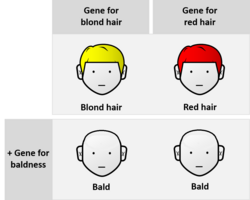Epistasis
Epistasis is the interaction between genes at different loci.[1] It was a term invented by William Bateson in 1909.[2]
When Gregor Mendel did his experiments on the sweet pea, he chose seven traits, such as round vs wrinkled peas, and tall vs short plants. He found the plants had pairs of 'factors' (genes) which controlled their appearance (phenotype). However, one pair of factors never affected the other pairs. But with epistasis, the action of one gene does affect another gene, even one on a different chromosome.
Use of the term has varied somewhat.[3] Its original meaning was quite narrow: for instance, a gene for no wings in Drosophila will obviously mask genes for any other aspect of the wings. In general, however, epistasis denotes any departure from independence of the effects of different genetic loci.
Epistasis Media
An example of epistasis is the interaction between hair colour and baldness. A gene for total baldness would be epistatic to one for blond hair or red hair. The hair-colour genes are hypostatic to the baldness gene. The baldness phenotype supersedes genes for hair colour, and so the effects are non-additive.[source?]
Quantitative trait values after two mutations either alone (Ab and aB) or in combination (AB). Bars contained in the grey box indicate the combined trait value under different circumstances of epistasis. Upper panel indicates epistasis between beneficial mutations (blue). Lower panel indicates epistasis between deleterious mutations (red).
References
- ↑ More precisely, the nonreciprocal (one-way) interaction of non-allelic genes: King R.C. Stansfield W.D. & Mulligan P.K. 2006. A dictionary of genetics, 7th ed. Oxford. p146
- ↑ Bateson, W. 1909. Mendel's principles of heredity. Cambridge.
- ↑ Cordell, Heather J. 2002. Epistasis: what it means, what it doesn't mean, and statistical methods to detect it in humans. Human Molecular Genetics 11, 2463-2468


